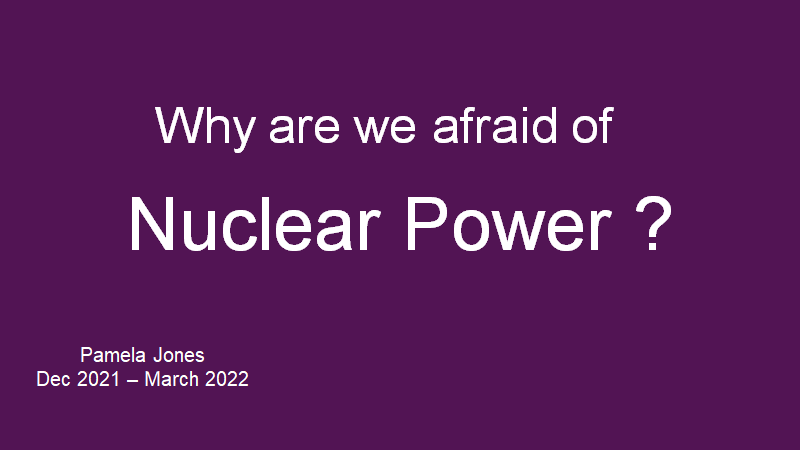
When nuclear reactions occur, two main forms of energy are released: heat and radiation. Radiation is used in nuclear power plants to cause more nuclear reactions to occur to keep the power plant operating. The heat is collected by a “cooling system” and makes steam which then drives turbines and generates electricity. Most of a nuclear power plant runs in a very similar way to electricity generation by a coal -fired or gas power plant. They all have turbines and cooling systems. When we burn coal, gas or wood, the energy is released in two main forms: heat and radiation. In this case, the radiation is in the form of infra-red radiation and light which is not so useful except perhaps psychologically sitting in front of an open fire.
There are about 440 nuclear power plants in operation in 33 countries. Australia is not one of these. Australia is the only G20 country where nuclear power is banned by Federal law. Nuclear power production is currently not permitted under two main pieces of Commonwealth legislation—the Australian Radiation Protection and Nuclear Safety Act 1998 (the ARPANS Act), and the Environment Protection and Biodiversity Conservation Act 1999 (the EPBC Act).
Nuclear power plants provide 10% of the world’s electricity. It is one of the safest sources of power generation. It produces no CO2 or other pollutants during operation and is the only source of power where every stage of the entire life cycle is securely contained.
Civil nuclear power has more than 18,000 reactor years of experience. The first commercial power plants were built over 50 years ago in the 1960s. Many of the world’s current nuclear power plants were built decades ago and for many years, few new reactors were built due to the campaigns by antinuclear groups and community concerns following Chernobyl. This was concerning as the new technology with greatly improved safety and efficiency was not being implemented. Safety features were no longer just added on as the technology advanced but were an integral part of the designs.
A year ago, the USA and major countries in Europe were setting dates to rid themselves of nuclear. Even France that had 70% of its electricity produced by nuclear power plants was winding down the industry. Sweden was replacing nuclear with wind power and Germany was determined to close all its nuclear power plants. However, other parts of the world, particularly Asia, had a different view and saw nuclear as an important part of the energy mix. About 55 power reactors are currently being planned or constructed in 19 countries.
In 2022, attitudes seem to be changing. France’s president Emmanuel Macron has announced plans to relaunch the country’s commercial nuclear programme with the construction of at least six new nuclear power reactors – and the possibility of eight more for a total of 14 – if he is re-elected. He also announced he wants to extend the lifespan of older nuclear plants to 50 years or more from 40 years currently, provided it was safe to do so. Japan shut down most of its nuclear power plants following the Fukushima event but has then gradually reopened each plant following extensive safety assessment and refurbishment.
Over recent weeks, several Eastern European countries have stated they need nuclear power if they are to reach their 2050 climate goals.
The first set of blogs accompanying my PowerPoint slides provide some basic material on radioactivity and uranium, fact checks issues that worry most of us and asks the question “Why are we afraid of nuclear power?”.